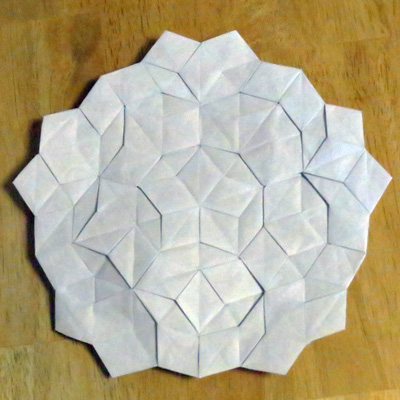You may recall that I started working on a new Penrose tessellation back in June at the convention. This turned out to be a really interesting challenge for a number of reasons. First, my initial attempts at a pattern for the tessellation were wrong because they didn’t go together according to the rules. There are lots of ways of joining the tiles the look correct at first but really aren’t once you start to grow the pattern. I learned alot about how to join Penrose tiles.
Second, I needed to systematically work out the widths of all the pleats. I discovered they came in at least four different widths. The ratios of the widths are all the golden mean, which I guess is not too surprising. More surprising is that the wide pleats tend to separate groups of tiles into clusters, like avenues, streets and alleys, or maybe branches on a tree. The groups are usually five tiles, sometimes ten, sometimes two or seven, and then these aggregate into larger groups.
In fact the whole pattern is fractal. I made a series of Penrose tessellations with 10, 35 and 70 tiles. For each one, you begin by precreasing the pattern of the previous tessellation and then subdivide it. This happens in an interesting way, since each tile subdivides into approximately 1.6 tiles, with the edge of parent tile forming the diagonal of a new tile.
I worked all this out when I was on vacation last month in Albany and Lake Placid. After that it took me a few weeks to actually fold the models. I’m satisfied that the approach can be taken to an arbitrarily large number of tiles. The next level out would be at least 120 tiles; the further out you go the harder it gets to find a logical stopping point. I might do that eventually, but for now I think I’m going to fold a 70’er out of good paper and declare victory. I suppose I ought to document the crease pattern too. But after that, I’ve been focused on pentagram-symmetry subjects long enough. It’s time to move onto other things.
Like compound polyhedra with a color change!
